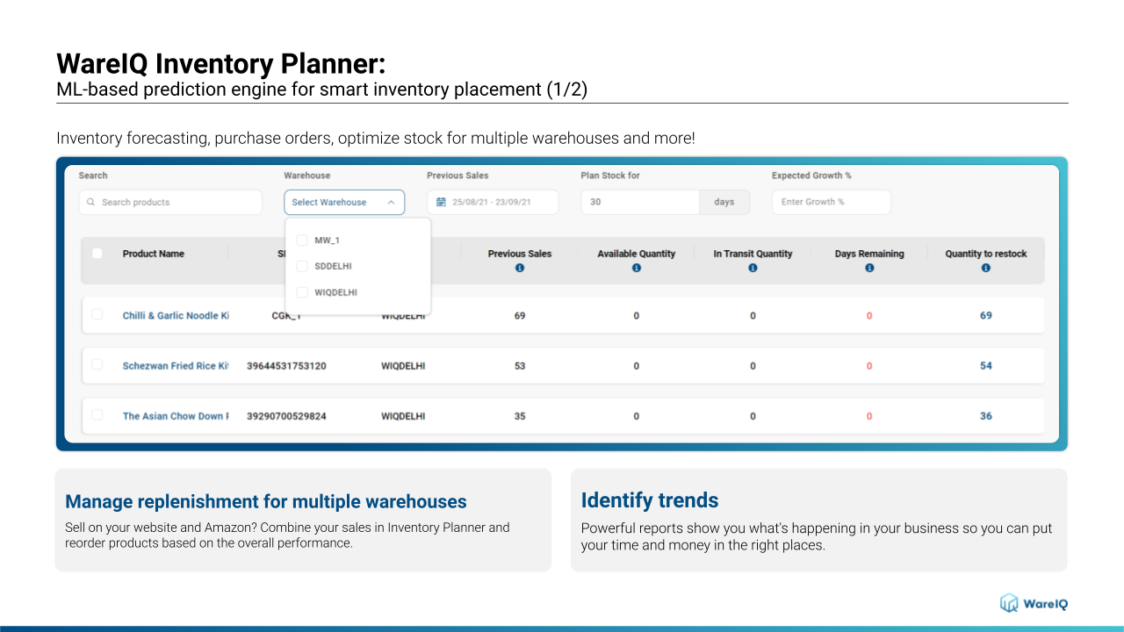Buffer Inventory: Meaning, Importance, Differences With Safety Stock, Benefits & Disadvantages In 2022

There are many variables and uncertainties that make operating an eCommerce business extremely difficult. Retailers constantly have to maintain the right amount of inventory to be able to fulfill orders but also not store too much to risk the items becoming obsolete or expired. Buffer stock can help businesses get through this uncertainty and can also make sure that their customers are never left waiting to receive their orders. Let’s take a look at what buffer inventory is, how it can help your business, the pros and cons and much more.
- What is the Meaning of Buffer Inventory/Stock?
- Buffer Stock vs Safety Stock: What are the Differences?
- Why is Keeping Buffer Stock Important?
- Buffer Inventory Formula: Top 4 Methods to Calculate Buffer Stock
- Advantages and Disadvantages of Buffer Inventory
- 5 Buffer Stock Parameters
- Conclusion
- Buffer Inventory FAQs
What is the Meaning of Buffer Inventory/Stock?
An extra amount of commodities is held on hand to meet any unexpected future demand or supply variations; this stock is called buffer stock. It is a backup stock that keeps some buffer room for any uncertainties that may arise in the future.
Buffer inventory is typically used as a security net in an emergency, supply chain delays or an unexpected rise in demand. The quantity of buffer inventory you keep will be determined mainly by the items you offer, average production or order lead times and historical inventory data.
A business maintains this stock in transit or on hand to guarantee no production, supply or lead time interruption. This type of stock is also known as a strategic stock, safety stock or buffer inventory.
A business can make use of buffer stock at any point along the supply chain. The primary purpose is to keep production or sales processes operating smoothly.
WareIQ, an eCommerce fulfillment company, empowers online brands with a superior-tech platform to compete with Amazon like service levels by bringing their average delivery timelines from 5-10 days to 1-2 days.
Buffer Stock vs Safety Stock: What are the Differences?
The words ‘buffer inventory’ and ‘safety stock’ are used synonymously to refer to the additional stock that a business entity keeps on hand to act as a shield against supply and demand fluctuations.
In certain circumstances, ‘buffer/safety inventory’ refers to inventory stored specifically for unexpected increases in product demand (for example, a promotion that generates more sales than planned), whereas ‘safety stock’ refers to inventory retained in the event of work-in-progress products or delays due to the supplier (e.g., manufacturing shutdown).
Both buffer stock inventory and safety stock serve the same function, i.e., guaranteeing an adequate inventory level to satisfy demand and fulfill orders on schedule.
Why is Keeping Buffer Stock Important?
Having buffer inventory is critical for your business since it allows you to save money on additional order fulfilment expenses while also providing your customers with a flawless shopping experience free of shipping delays.
In addition, like any other security net, buffer inventory may help you improve your operations. The importance of buffer stock is as follows:
- Buffer inventory may be located at any point along the supply chain and is meant to lessen the occurrence or severity of stock-out incidents, resulting in improved supply chain continuity and customer service.
- It can be used in manufacturing or other inventory-related scenarios to guarantee that unexpected shortages or requests may be fulfilled with some assurance.
- Safety stock is often retained during uncertainty about the product’s demand or lead time.
- The quantity of buffer stock a company decides to keep on hand on a general basis can have a significant impact on its operations.
- Overstocking can lead to excessive inventory carrying costs. But, conversely, stock-outs can repeatedly occur if there is insufficient stock. As a result, firms must strike a careful balance.
Buffer Inventory Formula: Top 4 Methods to Calculate Buffer Stock
Several factors influence how much inventory you keep on hand to function as a buffer. There is no generic solution for establishing how much buffer stock to keep. It has to be calculated based on factors that decide your business’s requirements.
There are various methods for calculating ideal buffer inventory levels, but regardless of the approach you use, you’ll need access to advanced analytics tools that help you control inventory by giving historical order data, SKU performance insights and demand forecasting statistics.
Having the relevant data at your disposal will allow you to appropriately determine the amount of buffer inventory needed to optimise inventory storage and guarantee that orders are completed on time.
Safety Stock Calculation
A safety stock formula is an excellent approach to quickly estimate the ideal amount of buffer inventory in case of an unforeseen circumstance.
To calculate safety stock, you first need to calculate the average daily consumption of your product and multiply it by the typical lead time, i.e. the number of days it takes between the time an order is first placed and delivered to your customer.
Then deduct your maximum daily use and multiply it by your max lead time.
The result is the product’s safety stock number.
You’ll need to know the maximum daily consumption, maximum lead time, average daily usage and average lead time to calculate this value.
The formula for safety stock calculation is as follows:
(Maximum daily sales x Maximum lead time) – (Average daily usage x Average lead time)
Hezier and Render’s Method
The buffer inventory approach proposed by Hezier and Render employs the standard deviation of the lead time distribution and the required service factor (i.e., the probability that a stockout will not take place).
Based on historical supply chain delays, this provides a more realistic picture of the amount of buffer inventory you should keep on hand.
The Hezier and Render technique is computed by multiplying your desired service factor (Z) by the standard deviation in lead time (𝜎LT) and the extent and frequency with which the average lead time varies from the actual lead time.
The formula for calculation using the Heizer and Render technique is as follows:
Z x 𝜎LT
Analysts utilise such a calculation when the supply is questionable. By utilising the standard deviation of the lead time distribution, it provides a more accurate picture.
As a result, it delivers a more precise and accurate picture of late shipments’ lead time and frequency. This model, however, does not account for fluctuations in demand.
Greasley’s Method
Greasley’s inventory calculation approach considers the standard deviation of lead time, desired service factor and average demand. The standard deviation in lead times refers to the unpredictability or volatility in lead times. In contrast, average demand denotes the number of items required to fulfill consumer demand during a specific period.
The formula is denoted as follows:
𝜎LTx average demand x Z
This strategy is typically utilised when demand and lead time fluctuate greatly. However, it does not consider the number of products that are still in production and are not yet available for sale.
Historical Demand-Based Buffer Inventory
Another method for calculating buffer inventory is obtaining and analysing historical data by evaluating inventory and order data.
When you know the inventory turnover rate, SKU performance and other details, you can sensibly assess your safety stock.
It’s usually a good idea to access previous order and inventory data, regardless of how you calculate the buffer inventory. Inventory forecasting necessitates substantial preparation to guarantee that your company is ready to satisfy demand constantly while remaining mindful of not purchasing too much (which may increase the costs of storing excess inventory and decrease the profit margin).
With demand forecasting technologies, you can quickly combine all the supply chain data from numerous channels to present an overview of the actual product and sales insights and forecasts.
Advantages and Disadvantages of Buffer Inventory
Advantages
The advantages of a business having buffer inventory are as follows:
- It assists in protecting the business against variations in demand and supply
- It aids in minimising production disturbance
- It contributes to the company’s revenue stability
- Because the firm has stock to take new orders, it decreases the odds of opportunity loss.
Disadvantages
Though having buffer inventory may prove to be beneficial to the business, it also comes with a few disadvantages that are stated below:
- Storing inventory in buffer may result in losses if the items are perishable or have limited shelf life
- Building and preserving might incur significant expenditures and add to the overhead costs
- More space will be required to accommodate the extra inventory
5 Buffer Stock Parameters
Accuracy in Forecasting
Accurate forecasting is crucial to understand buffer inventory. Forecasting demand and supply can assist in determining the amount of buffer stock that is necessary.
Adjustment of Lead Time
The lead time is defined as the time it will take for a firm to create a particular quantity of goods. Planning buffer stock must be in tandem with the lead time or else stocking will either be delayed or arrive sooner than anticipated.
Frequency of Refilling
The patterns and previous frequency of refilling might assist in restocking the supply. For example, the frequency of refilling once a month can help a company prepare more effectively for unforeseen circumstances.
Perishability of Products
The shelf life or perishability of commodities is a critical factor in buffer inventory planning.
A product with a higher rate of perishability must be handled differently than a product that does not perish quickly.
Seasonal fluctuations
Seasonal differences must also be taken into account while keeping buffer inventory.
Since the same product may sell more in the summer than in the winter, or vice versa, buffer stock cannot remain identical for both seasons.
Conclusion
Inventory management is critical for any organisation that wants to stay competitive and profitable while expanding its operations. Inventory shortages can result in missed sales. But on the other hand, excessive inventory results in more storage and administration costs and therefore, lower profit margins.
Working with a dependable distribution partner like WareIQ to manage your inventory helps increase manufacturing efficiency. It also liberates resources, concentration, and energy for growth and development.

Taking care of essential resources is critical for manufacturing competitiveness. Businesses that decrease managerial distractions cut inventory carrying costs and can focus on core skills, thus gaining a competitive edge. Outsourcing inventory management can help you achieve these objectives.
- Pan India Fulfillment & Darkstore Network: Plug-and-play fulfillment infrastructure with no minimums, which is compliant with Amazon Seller Flex, Flipkart Assured, Myntra and other marketplaces
- Inventory & Network Planning Excellence: Best-in-class AI models for sales forecasting, product segmentation, and inventory management to reduce inventory by 40% and increase revenue by 10%.
- Vertically Integrated Fulfillment Tech Stack: Our Fulfillment Tech Solution supports integrations with 20+ top marketplaces & D2C platforms, and prominent national, regional and hyperlocal couriers, enhancing reach by covering deliveries for 27,000+ pin codes
- Supply Chain Productivity Applications: Integrate a host of supply chain productivity apps with a single-click to your existing CRMs, ERPs & accounting software to manage your logistics workflows from one command center. Use Apps like RTO Shield to get 100% RTO protection, Branded Tracking to turn your order tracking page into a profitable marketing channel, and many more.
Trusted by 300+ top Indian brands, we are helping them accelerate online sales and expedite their growth through a synergistic combination of advanced technology, robust fulfillment infrastructure & seller enablement services!WareIQ is backed by leading global investors including Y Combinator, Funders Club, Flexport, Pioneer Fund, Soma Capital, and Emles Venture Partner.







